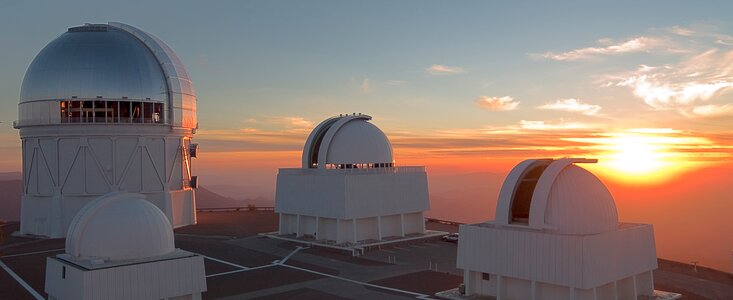ann18004 — Announcement
Solar Science Teams Selected for 2019 Eclipse at CTIO
18 October 2018
July 2nd 2019 will be a very special day in South America. On that day a total eclipse will travel from west to east across the continent and, in a spectacular stroke of astronomical luck, will pass directly over the National Science Foundation’s Cerro Tololo Inter-American Observatory in Chile – one of the most famous astronomy sites in the world. Cerro Tololo is a complex of astronomical telescopes and instruments located at an altitude of 7200 feet and part of the National Optical Astronomy Observatory (NOAO).
Science experiments conducted during a solar eclipse contribute rare and valuable data to our understanding of the Sun and its corona. Given the fortuitous passage of the eclipse path, AURA decided to open up the Cerro Tololo site to eclipse astronomers from around the world through a competition judged by solar physics experts from the National Solar Observatory. International teams of scientists applied for space on the mountain and now, five top-notch teams have been awarded access to this fantastic location to study the total eclipse. Each proposal was reviewed on its scientific originality, technical feasibility given the remote location and winter weather, and the impact the research will have locally or internationally.
The winning teams have been awarded accommodation at the summit, an observing pad on which to set up their experiment, internet connection and electricity. The high vantage point and reduced atmosphere will make for excellent conditions for viewing the tenuous solar corona.
Successful teams are:
- Williams College, Dr. Jay Pasachoff and his team will image the Sun’s corona using a technique that has been used during eclipses for more than a decade. Dr. Pasachoff has witnessed 70 total eclipses and will be focused on observations that will inform predictions of the next solar cycle.
- Dr. Shadia Habbal and her “Solar Wind Sherpas” from the University of Hawai’i will be using spectroscopic techniques to decipher the chemical composition, temperature, density, non-thermal motions and outflows of the different constituents of the coronal plasma, as well as probing unusual temperature structures around filaments on the Sun.
- A team from UCAR’s High Altitude Observatory, led by Principal Investigator Dr. Paul Bryans. Dr. Bryans team will analyze the Sun’s magnetic field using polarimetric images of the Sun’s corona in near-infrared light. This project will complement the NSF-funded AIR-Spec observations that will simultaneously measure the spectra from an airborne platform.
- Dr. Miquel Serra-Ricart from Instituto de Astrofísica de Canarias (IAC) in Tenerife, Spain will use the eclipse to investigate the changes in temperature of the Earth’s atmosphere and in particular the ionosphere, as the shadow passes overhead. Understanding how the ionosphere response to changes in solar input (which is removed temporarily during an eclipse) has great value for space weather predictions.
- Dr. Yoichiro Hanaoka from the Solar Science Observatory of National Astronomical Observatory of Japan will lead an endeavor to probe the near-Sun corona, which is a region of the solar atmosphere that is not well covered by spaceborne instruments. Combing their efforts with others spread across the path of totality will increase the duration of the observation past the few minutes of totality over any one spot.
In addition to their science objectives, each team has outlined an outreach plan that involves engaging local Chilean and foreign students, amateur astronomers and the general public in the wondrous experience of eclipse chasing. A combination of English and Spanish speaking teams will be well positioned to get local youth excited about this, and future eclipses, as well as giving some of them the opportunity to actually participate in the eclipse observing.
The Association of Universities for Research in Astronomy (AURA) is an international consortium of universities and non-profit institutions that operate world-class astronomy facilities including the National Solar Observatory, the National Optical Astronomy Observatory, Gemini Observatory, the Large Scale Synoptic Telescope, and the Space Telescope Science Institute. In Chile, AURA administers and operates the telescopes of Cerro Tololo, Gemini South, SOAR and the future LSST under a cooperative agreement with the National Science Foundation of the United States.
Links
See more on: https://www.aura-astronomy.org/news/

